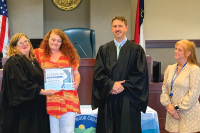Ellison just plain wrong about Granville Calhoun
 To the Editor:
To the Editor:
I have read with interest the original article by George Ellison questioning the account that Granville Calhoun has provided about the trip of Horace Kephart to Hazel Creek in 1904 and the response made to that article by Granville’s great niece Gwen Franks Breese and Mr. Ellison’s response to her letter. Quite frankly I am appalled by Mr. Ellison’s largely unsupported position that the story related by Mr. Calhoun was false.
I am the son-in-law of the late Edwin B. Whitaker, whose family lived in Bryson City across the street from members of the Calhoun family. While I never had the pleasure of meeting Granville, I have spent considerable time with his relatives: Mrs. Breese, her mother (Granville’s niece) and grandmother (Granville’s sister-in-law). There is no question that the Calhoun family was and is composed of the most forthright, upstanding and honest individuals one could ever meet. This is not just my opinion; it is the opinion of everyone that I have ever met in Bryson City over the past 45 years. It is extremely difficult, almost impossible, to entertain the idea that any member of the Calhoun family would ever have invented any story about Horace Kephart, or anything else.
Mr. Ellison says “But all of the tangible evidence now available seems to indicate that he was apparently quite sober from Nov. 1, 1904, when he left Dillsboro, until he arrived at the cabin on the Little Fork of the Sugar Fork of Hazel Creek on Nov. 2, 1904.” This statement is simply false. There is no independent evidence to dispute Granville Calhoun’s version of the events and no outside independent evidence to support Mr. Ellison’s speculations.
The strongest evidence with respect to what happened is the direct testimony of Granville as related in the Frome book and elsewhere. And as Mrs. Breese indicates in her letter, Granville had repeated this story to others. While Verayle Franks and Nora Lee Calhoun are deceased, I can affirm that Robert Breese is alive and well and his testimony as to what Granville has said is also credible evidence.
Related Items
The recitation of events by Granville as reported in the Frome book has been out there for more than 45 years. When it was published in 1967, did anyone come forward to dispute Granville’s version? In all of the time since then has anyone who was living during the events or had documents relating to them come forward to dispute Granville’s version? Where is that testimony?
Consider Bryson City pharmacist Kelly Bennett, who was a contemporary of Granville and a close companion to Horace Kephart. Mr. Bennett obviously knew of Granville’s story, he must have heard the story many times and he died years after its publication in the Frome book. His papers are housed at Appalachian State University, and while I have only reviewed the index of those papers (which should be sufficient using Mr. Ellison’s methods) I have been informed by a noted historian of the area who has reviewed that collection extensively that there is nothing in those papers which contradicts Granville’s version of the events.
Now note the lack of independent evidence supporting Mr. Ellison’s view. One piece of so-called tangible evidence that Mr. Ellison offers is a meaningless contradiction in description of wine that was provided to Horace Kephart. Furthermore, the entries in the index to Kephart’s diaries are not reliable evidence of the events. In order to accept Mr. Ellison’s view one must accept the idea that not only he can discern actual diary entries from short index notations, but that he can also determine that the man who wrote those unseen entries was sober. A much more reasonable explanation of any discrepancy between the interpretation of the diary index and the events as described by Granville is not that Granville’s account was fabricated but that Kephart’s version is the result of a mind in chaos.
Mr. Kephart’s notation that he lived in the cabin starting Nov. 2, 1904, was written many years after that event occurred. Mr. Ellison refers to Horace Kephart as a binge drinking alcoholic and then asks everyone to accept that caption as the truth despite the fact that being a chronic alcoholic would have rendered Kephart’s recollection of the timing of an event totally unreliable. Granville Calhoun who was actually there has provided an eyewitness account to many individuals and his mind was not clouded by chronic alcoholism.
Finally, there is simply no reason why Granville would have made up the story. It doesn’t fit a “tall tale” description, it is not humorous or entertaining or imaginative. But there would have been strong motivation for Mr. Kephart to revise history and hide the fact that his severe alcoholism in October/November 1904 caused him to come under the care of Granville Calhoun, if he was even aware of that happening. As with many alcoholics, the disease may have totally obliterated that memory from Mr. Kephart’s mind. He may well have thought that he went from Sylva to his cabin near Hazel Creek in one day, without having to be tended by Granville Calhoun for three weeks, but that doesn’t make it true. And none of this takes away from the fact that while highly qualified Kephart researchers have documented issues with respect to his depiction of mountain people and his accuracy as to events, locations and outdoor activities, Kephart’s writings are truly magnificent literature.
So the logical conclusion is that absent additional documented contemporary reports or documented disputes by his contemporaries of his version of the events, Granville Calhoun’s description of the events is correct and that Mr. Ellison’s 110 years after the fact speculations are simply not supportable or sustained. Mr. Ellison complains that Mrs. Breese in her response to his original commentary failed to mention the materials he cited. I would assume that this was because those materials were so insubstantial.
Sidney R. Finkel
Fairview









